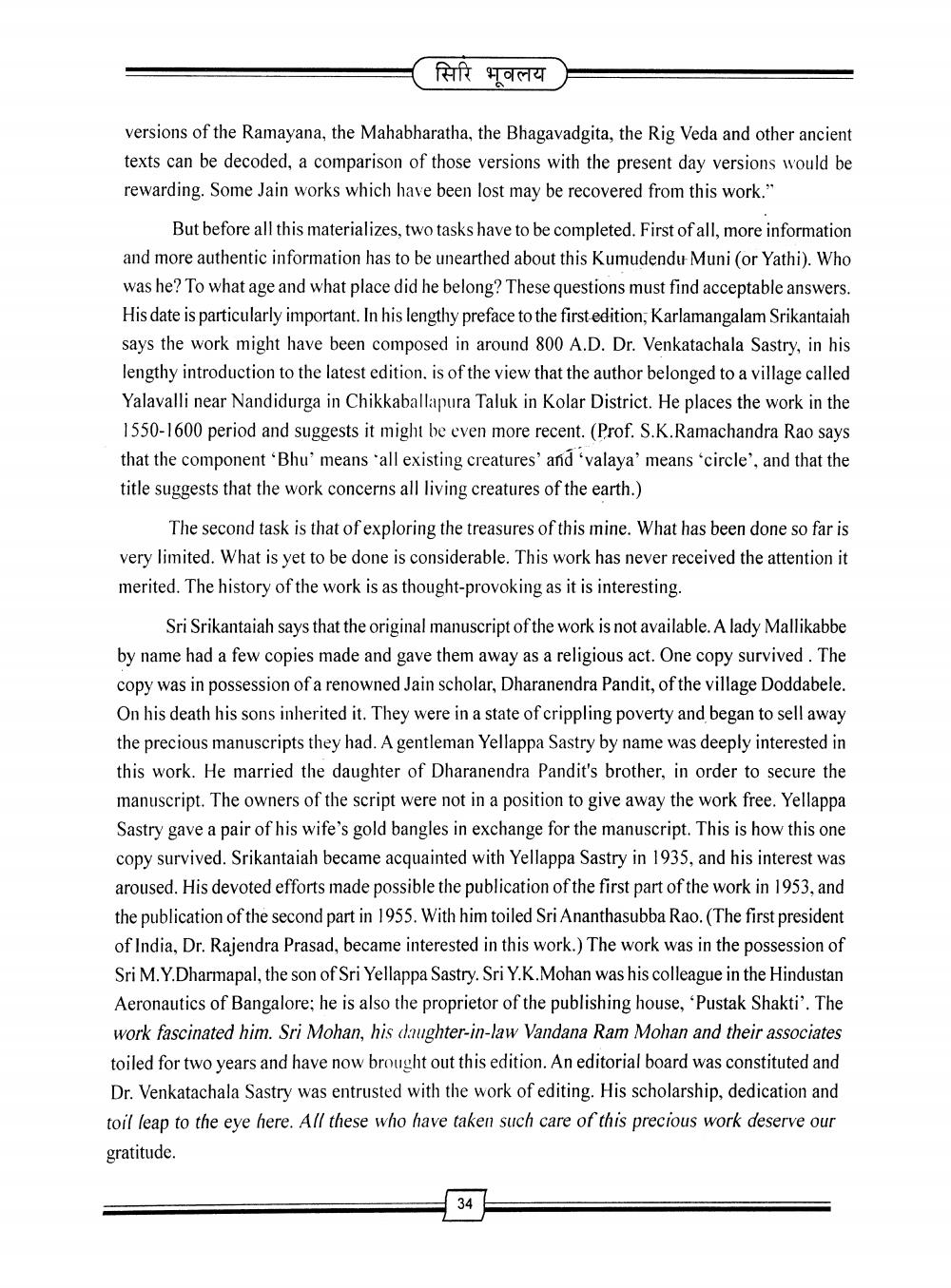________________
भूवलय
versions of the Ramayana, the Mahabharatha, the Bhagavadgita, the Rig Veda and other ancient texts can be decoded, a comparison of those versions with the present day versions would be rewarding. Some Jain works which have been lost may be recovered from this work."
But before all this materializes, two tasks have to be completed. First of all, more information and more authentic information has to be unearthed about this Kumudendu Muni (or Yathi). Who was he? To what age and what place did he belong? These questions must find acceptable answers. His date is particularly important. In his lengthy preface to the first edition, Karlamangalam Srikantaiah says the work might have been composed in around 800 A.D. Dr. Venkatachala Sastry, in his lengthy introduction to the latest edition, is of the view that the author belonged to a village called Yalavalli near Nandidurga in Chikkaballapura Taluk in Kolar District. He places the work in the 1550-1600 period and suggests it might be even more recent. (Prof. S.K.Ramachandra Rao says that the component 'Bhu' means all existing creatures' and 'valaya' means 'circle', and that the title suggests that the work concerns all living creatures of the earth.)
The second task is that of exploring the treasures of this mine. What has been done so far is very limited. What is yet to be done is considerable. This work has never received the attention it merited. The history of the work is as thought-provoking as it is interesting.
Sri Srikantaiah says that the original manuscript of the work is not available. A lady Mallikabbe by name had a few copies made and gave them away as a religious act. One copy survived. The copy was in possession of a renowned Jain scholar, Dharanendra Pandit, of the village Doddabele. On his death his sons inherited it. They were in a state of crippling poverty and began to sell away the precious manuscripts they had. A gentleman Yellappa Sastry by name was deeply interested in this work. He married the daughter of Dharanendra Pandit's brother, in order to secure the manuscript. The owners of the script were not in a position to give away the work free. Yellappa Sastry gave a pair of his wife's gold bangles in exchange for the manuscript. This is how this one copy survived. Srikantaiah became acquainted with Yellappa Sastry in 1935, and his interest was aroused. His devoted efforts made possible the publication of the first part of the work in 1953, and the publication of the second part in 1955. With him toiled Sri Ananthasubba Rao. (The first president of India, Dr. Rajendra Prasad, became interested in this work.) The work was in the possession of Sri M.Y.Dharmapal, the son of Sri Yellappa Sastry. Sri Y.K. Mohan was his colleague in the Hindustan Aeronautics of Bangalore; he is also the proprietor of the publishing house, “Pustak Shakti'. The work fascinated him. Sri Mohan, his daughter-in-law Vandana Ram Mohan and their associates toiled for two years and have now brought out this edition. An editorial board was constituted and Dr. Venkatachala Sastry was entrusted with the work of editing. His scholarship, dedication and toil leap to the eye here. All these who have taken such care of this precious work deserve our gratitude
34




